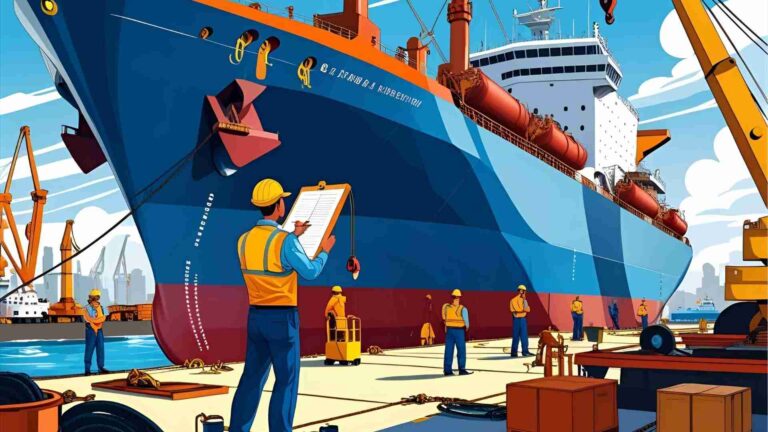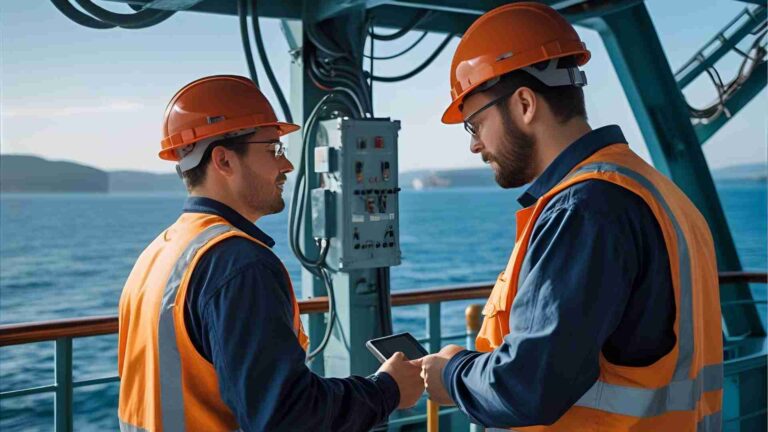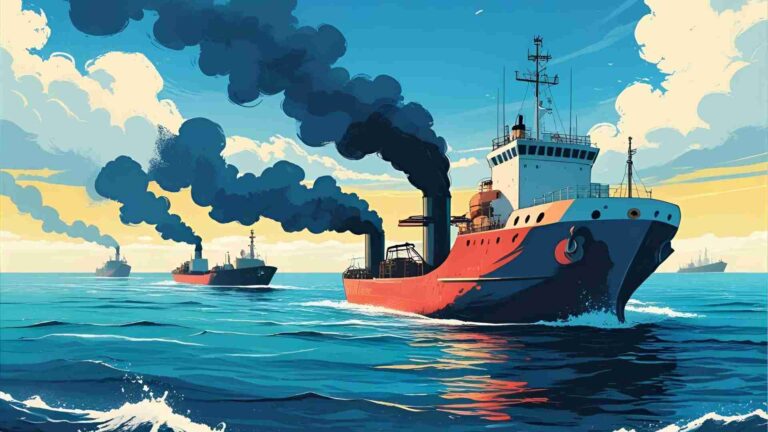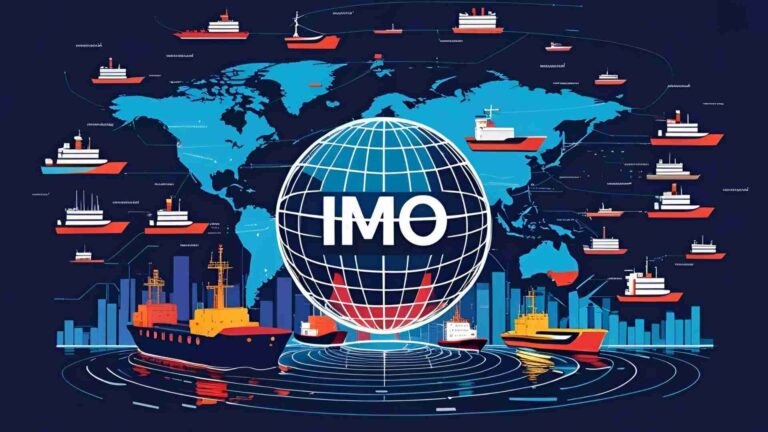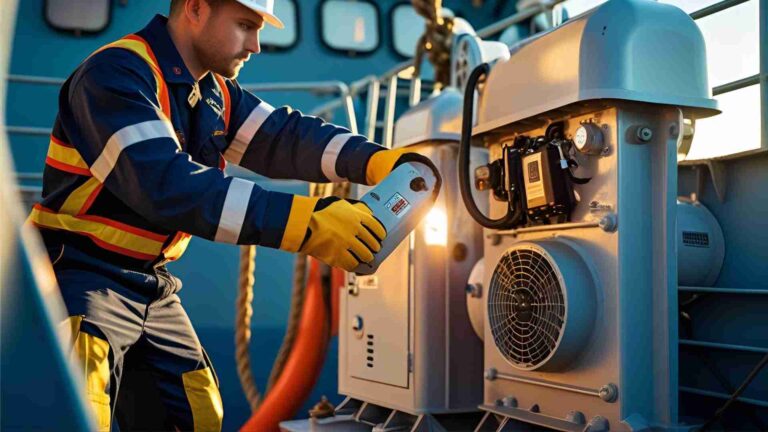100 Exam Questions with Short Answers for 3rd Engineers in Italy
Marine engineering is a critical field requiring expertise in machinery operation, safety protocols, and environmental compliance. For 3rd Engineers in Italy preparing for examinations or seeking to enhance their professional knowledge, this guide provides 100 meticulously crafted questions and answers. These cover advanced engineering principles, electrical and automation systems, machinery maintenance, safety procedures, and compliance with international regulations like MARPOL, SOLAS, and the ISM Code. Designed to be a definitive resource, this article ensures clarity, technical accuracy, and practical relevance for marine engineers.
The Role of a 3rd Engineer
The 3rd Engineer is a key member of a ship’s engine department, responsible for operating and maintaining critical systems, ensuring safety, and complying with environmental regulations. Their duties include monitoring propulsion and auxiliary systems, conducting maintenance, managing emergencies, and maintaining accurate records. This guide addresses these responsibilities through targeted questions and answers, equipping engineers with the knowledge needed to excel.
Questions and Answers for 3rd Engineers
1. What are the causes of asynchronous motor shutdown in a diesel generator?
Answer: Asynchronous motor shutdowns in diesel generators can result from:
- Overheating: Due to inadequate cooling, blocked air vents, or overloading.
- Electrical Faults: Short circuits, insulation failure, or damaged windings.
- Mechanical Issues: Bearing failure, misalignment, or rotor damage.
- Loss of Excitation: Failure in the excitation system, disrupting the magnetic field.
Solution: Regular maintenance, cooling system checks, and electrical inspections prevent shutdowns.
2. What is the purpose of a ship’s wheelhouse?
Answer: The wheelhouse is the ship’s control center, housing navigational equipment like radar, GPS, ECDIS, and communication systems. The bridge team, led by the officer on watch, uses it to navigate and manage the vessel. It is designed for maximum visibility and complies with IMO standards.
3. How does a bilge separator function in the engine room?
Answer: A bilge separator removes oil from bilge water to meet MARPOL Annex I requirements (oil content <15 ppm). It uses coalescing plates and gravity separation to isolate oil, which is stored for disposal, while clean water is discharged.
4. What are tank pressure tests on ships?
Answer: Tank pressure tests (hydrostatic tests) verify the integrity of a ship’s tanks by filling them with liquid (usually water) and applying pressure to detect leaks or structural weaknesses. These tests comply with IMO and classification society standards.
5. What are the key provisions of MARPOL Annexes V and VI?
Answer:
- Annex V: Regulates garbage disposal, requiring ships to have garbage management plans and restrict waste discharge, especially plastics, into the sea.
- Annex VI: Addresses air pollution, limiting NOx, SOx, and particulate emissions, and establishing Emission Control Areas (ECAs) with stricter standards.
6. Describe the ship fuel bunkering procedure.
Answer: Bunkering involves:
- Planning: Verifying fuel type, quantity, and delivery schedule.
- Safety Measures: Ensuring proper PPE, spill kits, and communication with the bunker barge.
- Monitoring: Checking for leaks, verifying fuel quality, and measuring quantity.
- Documentation: Recording details in the Oil Record Book per IMO guidelines.
7. What is supercharging in marine diesel engines?
Answer: Supercharging increases air intake to enhance combustion and power output using turbochargers or superchargers. It improves engine efficiency and reduces emissions by optimizing fuel burn.
8. What is the purpose of the engine room logbook?
Answer: The engine room logbook records all engineering activities, including maintenance, repairs, fuel consumption, and operational events. It ensures compliance with flag state and ISM Code requirements, serving as a legal and operational record.
9. How do speed and voltage regulators function for electromotors on ships?
Answer: Speed and voltage regulators stabilize pump and motor performance by adjusting power input to maintain consistent speed and voltage, preventing equipment damage from fluctuations.
10. What are marine boilers, and what are their functions?
Answer: Marine boilers generate steam for propulsion, heating, or electricity generation. They use fuel or waste heat to boil water, and the steam is distributed via pipes. They must comply with SOLAS safety standards.
Types of Marine Boilers
| Type | Fuel Source | Application | Efficiency |
|---|---|---|---|
| Water-Tube Boiler | Oil/Gas | Propulsion, Power | High |
| Fire-Tube Boiler | Oil/Gas | Heating, Auxiliary | Moderate |
| Exhaust Gas Boiler | Waste Heat | Power Generation | High |
11. What are MARPOL Annexes I and II?
Answer:
- Annex I: Prevents oil pollution by regulating oil discharge and requiring oily water separators.
- Annex II: Controls pollution from noxious liquid substances, specifying discharge and segregation rules.
12. What is the ISM Code?
Answer: The International Safety Management (ISM) Code ensures safe ship operation and pollution prevention through a safety management system (SMS). It includes policies, procedures, and emergency protocols.
13. How do hydraulic systems function on ships?
Answer: Hydraulic systems use pressurized fluid to power machinery like steering gears, stabilizers, and hatch covers. Components include pumps, valves, actuators, and fluid reservoirs. Regular maintenance ensures reliability.
Hydraulic System Flow

14. How are marine diesel engines protected from failures?
Answer: Protection systems monitor temperature, pressure, and vibration, triggering alarms or shutdowns if anomalies occur. Regular maintenance and sensor calibration ensure reliability.
15. What are fluid operating machines on ships?
Answer: Fluid operating machines, like pumps and compressors, transfer energy to move fluids or gases. They are critical for cooling, fuel transfer, and air supply, requiring regular maintenance.
16. What are open-loop and closed-loop systems on ships?
Answer:
- Open-Loop: Systems like seawater cooling take in and discharge fluid to the environment.
- Closed-Loop: Systems like freshwater cooling recirculate fluid via heat exchangers for temperature control.
17. Describe diesel lubrication systems and their safety features.
Answer: Diesel lubrication systems reduce friction using oil pumps, filters, and coolers. Safety features include pressure relief valves, bypass filters, and alarms for low oil pressure or high temperature.
18. What are the principles of axis line construction and visual checks?
Answer: Axis line construction ensures proper alignment of propulsion components (shaft, bearings, gearbox). Visual checks during shaft alignment verify alignment, reducing wear and vibration.
19. What devices measure onboard electrical systems?
Answer: Devices include multimeters, clamp meters, insulation testers, and power analyzers. They monitor voltage, current, and insulation resistance, requiring regular calibration.
20. How is a blackout resolved on a ship?
Answer: Blackout resolution involves:
- Identifying the cause (e.g., generator failure).
- Activating emergency generators.
- Restoring power through systematic troubleshooting.
- Conducting drills to ensure preparedness.
21. What are the notable points affecting ship stability?
Answer: Key points include:
- Center of Gravity (CG): Point where the ship’s weight is balanced.
- Center of Buoyancy (CB): Point where buoyant force acts.
- Metacenter (M): Determines stability based on CG and CB positions.
Moving weights affects stability, potentially causing list or capsizing.
22. What is vessel compartmentation?
Answer: Compartmentation divides a ship into watertight and fire-resistant compartments to enhance safety. It limits flooding or fire spread, complying with SOLAS regulations.
23. How do fresh water generators operate?
Answer: Fresh water generators produce potable water using evaporators, reverse osmosis, or plate heat exchangers. Maintenance includes descaling and membrane cleaning.
24. What causes engine shutdowns (asynchronous, synchronous, diesel)?
Answer: Causes include mechanical failures, electrical faults, thermal overload, or control system issues. Regular maintenance prevents unexpected shutdowns.
25. What is the role of PLCs on ships?
Answer: Programmable Logic Controllers (PLCs) automate systems like propulsion and power management, processing sensor inputs to control equipment, enhancing efficiency and safety.
26. How does weight displacement affect ship stability?
Answer: Moving weights shifts the center of gravity, affecting trim and stability. Stability diagrams visualize these changes to ensure safe loading.
27. What are the duties of an engineer officer during a fire?
Answer: Duties include raising alarms, securing fuel and ventilation, activating firefighting systems, and coordinating with the emergency team.
28. What does MARPOL Annex III regulate?
Answer: Annex III governs the transport of harmful substances in packaged form, requiring proper packaging, labeling, and stowage to prevent pollution.
29. How do liquid and diathermic fuel boilers and economizers work?
Answer: These boilers generate steam or hot water for shipboard use. Economizers recover exhaust heat, improving efficiency. Maintenance includes burner and tube cleaning.
30. How is fresh water produced and distributed on ships?
Answer: Fresh water is produced via reverse osmosis or evaporators and distributed through pipes and pumps. Regular monitoring ensures water quality.
31. What are the critical aspects of evaporator boiling and flash evaporation?
Answer: Proper temperature, pressure, and flow rates are crucial to prevent fouling, scaling, or corrosion, ensuring efficient freshwater production.
32. What measurements prevent electrical system failures?
Answer:
- Insulation Testing: Detects deteriorating insulation.
- Magneto-Thermal Protections: Prevents overcurrent damage.
- Frequency/Power Factor Monitoring: Ensures system stability.
33. How do electrical systems ensure safety onboard?
Answer: Insulation testing, fuses, and frequency meters protect against short circuits and overloads, with regular maintenance ensuring reliability.
34. What is the structure of a ship?
Answer: The ship’s structure includes a framework with longitudinal and transverse elements to withstand loads. Regular inspections ensure structural integrity.
35. What are routine tasks during engine room watch?
Answer: Tasks include monitoring engines, checking lubrication, inspecting for leaks, and addressing breakdowns promptly.
36. What are the properties of marine diesel engine lubricants?
Answer: Lubricants have specific flash points, pour points, and total base number (TBN) to reduce friction, prevent wear, and ensure safe operation.
37. What test devices are used for onboard electrical systems?
Answer: Insulation testers, vibration analyzers, current meters, and voltage meters monitor system health, requiring regular calibration.
38. What routine tasks ensure engine room safety?
Answer: Tasks include checking machinery, maintaining lubrication, and ensuring safety systems are operational.
39. What are the SOLAS requirements for vessel compartmentation?
Answer: SOLAS mandates watertight and fire-resistant bulkheads to contain emergencies, ensuring stability and safety.
40. Where are zinc anodes and impressed current systems located?
Answer: Zinc anodes are on hulls, propellers, and rudders. Impressed current systems (ICCP) apply external current to protect the hull from corrosion.
41. What causes frequency converter shutdowns in propulsion motors?
Answer: Causes include overheating, electrical faults, power imbalances, or drive system malfunctions. Troubleshooting ensures reliable operation.
42. What are the engineer officer’s duties during an engine room fire?
Answer: Raise alarms, shut down systems, activate firefighting equipment, and coordinate with the crew to contain the fire.
43. How does an oily water separator function?
Answer: Oily water separators remove oil from bilge water to <15 ppm, using coalescing and gravity separation, ensuring MARPOL compliance.
44. What safety measures are required for electrical welding?
Answer: Use PPE, ensure ventilation, analyze oxygen and explosiveness, and obtain gas-free certificates from a port chemist if welding in port.
45. What are the mechanical properties of shipbuilding materials?
Answer:
- Extensibility: Ability to stretch without breaking.
- Ductility: Ability to deform under stress.
- Breaking Load: Maximum load before failure.
- Internal Tensions: Forces within the material affecting strength.
46. What are the MLC 2006 rest hour requirements?
Answer: Seafarers must have 10 hours of rest in 24 hours and 77 hours in 7 days, with exceptions for emergencies.
47. What is a garbage management plan?
Answer: A garbage management plan outlines waste collection, storage, and disposal procedures per MARPOL Annex V to minimize environmental impact.
48. How does a reverse osmosis system work onboard?
Answer: Reverse osmosis filters seawater through a semi-permeable membrane to produce fresh water, requiring regular membrane maintenance.
49. What is the SOLAS Convention?
Answer: SOLAS sets minimum safety standards for ship construction, equipment, and operation, covering firefighting, life-saving appliances, and navigation.
50. What causes corrosion on ships, and how is it prevented?
Answer: Corrosion results from seawater, humidity, and oxygen exposure. Prevention includes zinc anodes, ICCP, and protective coatings.
Corrosion Prevention

51. What are the duties of a 3rd Engineer on a commercial ship?
Answer: Duties include maintaining engines, monitoring systems, ensuring compliance, managing emergencies, and keeping accurate logbooks.
52. How are marine diesel engines operated and maintained?
Answer: Operation involves monitoring fuel, air, and cooling systems. Maintenance includes lubrication checks, filter cleaning, and vibration analysis.
53. How is environmental compliance ensured onboard?
Answer: Compliance involves using low-sulfur fuels, maintaining oily water separators, adhering to MARPOL, and conducting regular audits.
54. What information is recorded in the engine room logbook?
Answer: Records include maintenance, repairs, fuel consumption, and operational events, ensuring regulatory compliance.
55. What are the principles of refrigeration and air conditioning systems?
Answer: These systems use refrigerants to absorb and transfer heat, maintaining temperature control. Maintenance includes checking compressors and refrigerant levels.
56. What is the function of a ship’s sewage treatment plant?
Answer: The plant treats sewage to meet MARPOL Annex IV standards, using biological or chemical processes for safe discharge or storage.
57. How is routine maintenance performed on marine diesel engines?
Answer: Tasks include checking oil levels, cleaning filters, inspecting cooling systems, and monitoring performance parameters.
58. What are the types of marine fuels, and how do they affect performance?
Answer:
- HFO: Cost-effective, high sulfur, requires purifiers.
- MGO: Low sulfur, used in ECAs, cleaner combustion.
- LNG: Low emissions, requires specialized storage.
- Biofuels: Sustainable, but may cause compatibility issues.
59. How does the ship’s electrical power system operate?
Answer: Generators produce power, distributed via switchboards. Maintenance includes insulation testing and generator checks.
60. What hazards are associated with the engine room, and how are they managed?
Answer: Hazards include fires, electrical shocks, and machinery failures. Management involves PPE, inspections, and drills.
61. What is the purpose of fire detection and firefighting systems?
Answer: Detection systems use sensors to identify fires, while firefighting systems (CO2, foam, water) extinguish them. Regular testing ensures functionality.
62. What is the function of a ballast water treatment system?
Answer: It disinfects ballast water using UV, filtration, or chemicals to prevent invasive species spread, per IMO regulations.
63. How is routine maintenance performed on the steering system?
Answer: Tasks include checking hydraulic fluid, inspecting gears, and testing rudder response.
64. How do sewage and gray water systems operate?
Answer: Sewage systems treat waste, while gray water systems collect and treat water from sinks and showers, ensuring MARPOL compliance.
65. What is the function of the bilge system, and how is it maintained?
Answer: The bilge system removes water from lower compartments. Maintenance includes cleaning separators and checking pumps.
66. How is safe operation of cargo handling equipment ensured?
Answer: Regular inspections, load testing, and crew training prevent accidents.
67. How do hydraulic systems operate on ships?
Answer: They use pressurized fluid to power machinery, requiring fluid level checks and leak inspections.
68. What is the function of the emergency generator?
Answer: It provides power during blackouts, requiring regular testing and fuel checks.
69. How does the air compressor system operate?
Answer: Compressors supply air for engine starting and tools, requiring moisture drainage and pressure checks.
70. How is safety equipment maintained?
Answer: Lifeboats, fire extinguishers, and other equipment require regular inspections and certification.
71. What is the function of a fuel oil purifier?
Answer: Purifiers remove water and impurities from fuel, ensuring engine efficiency. Maintenance includes cleaning and flow rate checks.
72. How does a fresh water generator operate?
Answer: It produces potable water via reverse osmosis or evaporation, requiring membrane cleaning and descaling.
73. What is the function of the lubrication system?
Answer: It reduces friction in engines using oil pumps, filters, and coolers, requiring regular oil analysis.
74. What is the stern tube system?
Answer: It seals the propeller shaft, preventing water ingress. Maintenance includes checking seals and lubrication.
75. How is routine maintenance performed on pumps and valves?
Answer: Tasks include checking for leaks, lubricating parts, and testing valve operation.
76. What is a waste heat recovery system, and how does it improve efficiency?
Answer: WHRS captures exhaust heat for power generation or heating, improving fuel efficiency.
77. How are marine boilers maintained?
Answer: Maintenance includes water treatment, burner cleaning, and tube inspections.
78. What is the function of the steering gear system?
Answer: It controls the rudder, requiring hydraulic checks and alignment tests.
79. What are main and auxiliary condensers?
Answer: Condensers convert steam to water, maintaining boiler efficiency. Maintenance includes tube cleaning.
80. How are electrical motors and generators maintained?
Answer: Tasks include insulation testing, bearing lubrication, and vibration analysis.
81. How does a reverse osmosis desalination plant operate?
Answer: It filters seawater through membranes to produce fresh water, requiring membrane cleaning.
82. What is the function of the inert gas system?
Answer: It reduces oxygen in cargo tanks to prevent explosions, requiring gas generator maintenance.
83. How is the sewage holding tank maintained?
Answer: Tasks include cleaning and ensuring pump functionality.
84. How is compliance ensured when operating machinery?
Answer: Regular audits, proper documentation, and crew training ensure compliance with MARPOL, SOLAS, and ISM Code.
85. How does the air conditioning plant operate?
Answer: It uses refrigerants to cool air, requiring filter cleaning and refrigerant checks.
86. What is the function of the fuel oil transfer system?
Answer: It transfers fuel to day tanks, requiring pump and filter maintenance.
87. How does the emergency fire pump operate?
Answer: It provides water during fire system failures, requiring regular testing.
88. How are air compressors maintained?
Answer: Tasks include draining moisture and checking pressure levels.
89. How does the waste oil incinerator operate?
Answer: It burns waste oil safely, requiring burner cleaning and emission checks.
90. What is the function of the shafting system?
Answer: It transmits power to the propeller, requiring alignment and bearing checks.
91. How does Selective Catalytic Reduction (SCR) reduce NOx emissions?
Answer: SCR injects urea into exhaust gases, converting NOx to nitrogen and water.
92. What are the benefits of LNG as a marine fuel?
Answer: LNG reduces SOx, NOx, and particulate emissions, and lowers CO2 compared to HFO.
93. What challenges do biofuels pose for marine engines?
Answer: Challenges include fuel stability, system compatibility, and microbial growth.
94. How does in-situ crankshaft grinding work?
Answer: It restores crankshaft surfaces using portable tools without engine disassembly.
95. What are the benefits of advanced hull coatings?
Answer: They reduce biofouling and drag, improving fuel efficiency and reducing maintenance.
96. What is predictive maintenance in marine engineering?
Answer: It uses sensors and data analytics to predict equipment failures, optimizing maintenance schedules.
97. What is the purpose of the Energy Efficiency Existing Ship Index (EEXI)?
Answer: EEXI assesses ship energy efficiency to reduce greenhouse gas emissions.
98. How do Exhaust Gas Cleaning Systems (scrubbers) work?
Answer: Scrubbers remove SOx using seawater or chemical solutions, ensuring IMO 2020 compliance.
99. What is the role of dynamic positioning (DP) systems?
Answer: DP systems maintain ship position using thrusters and sensors, eliminating the need for anchors.
100. How does digital twin technology enhance marine systems?
Answer: Digital twins create virtual replicas for real-time monitoring, predictive maintenance, and system optimization.
Conclusion
This guide provides 100 accurate and concise questions and answers tailored for 3rd Engineers in Italy, covering critical aspects of marine engineering, safety, and environmental compliance. From diesel engine maintenance to MARPOL regulations, these topics equip engineers with the knowledge needed to excel in examinations and professional roles. By integrating charts, tables, and diagrams, this resource enhances understanding of complex systems, ensuring 3rd Engineers are well-prepared to contribute to safe and efficient maritime operations.
Happy Boating!
Share 100 Exam Questions with Short Answers for 3rd Engineers in Italy with your friends and leave a comment below with your thoughts.
Read ISM Code: Establishing Safety Management System(SMS) for Ships until we meet in the next article.

